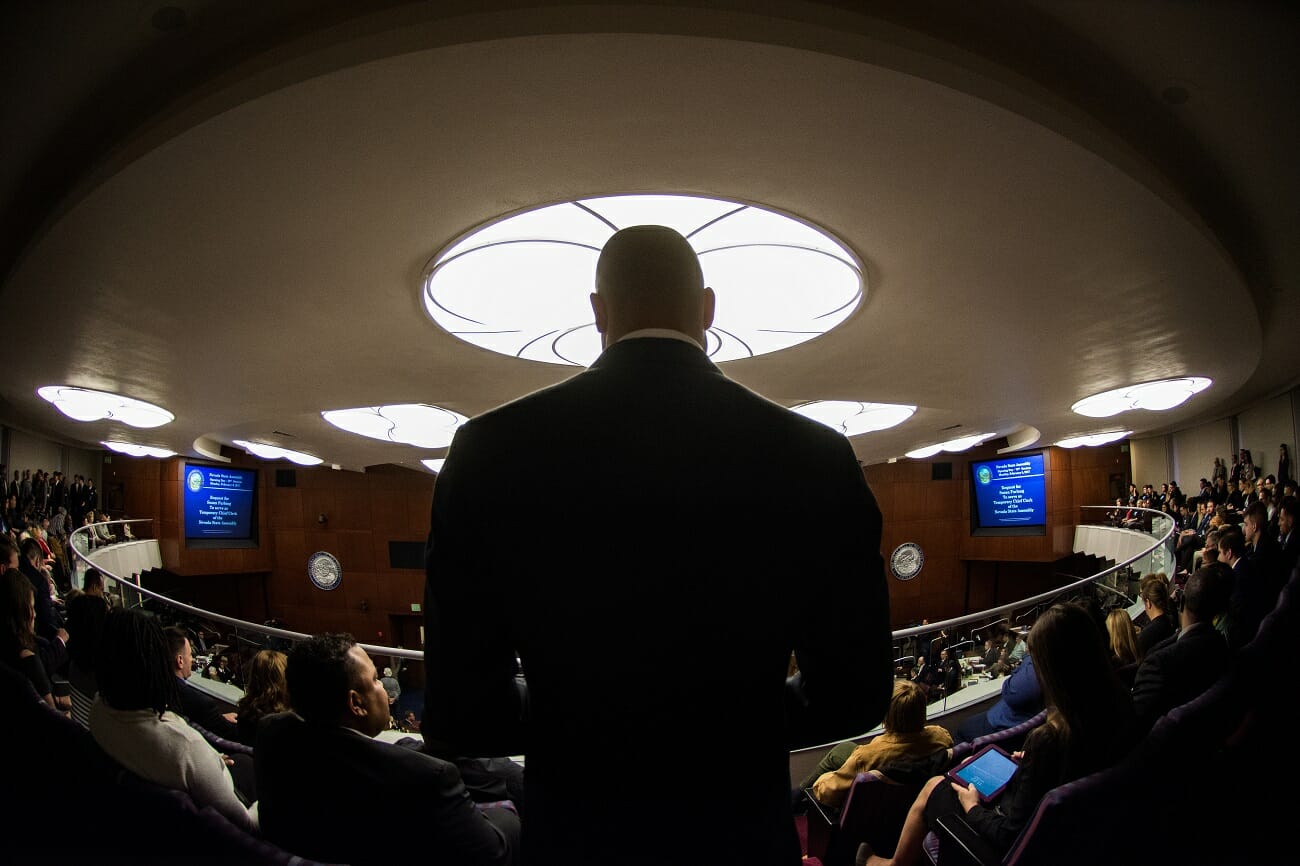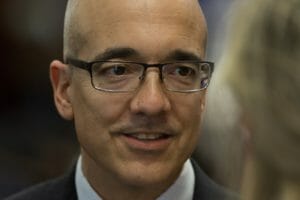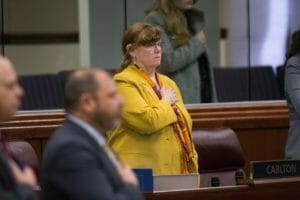Initial estimate of Democratic legislative priorities eclipses $1.6 billion

When Nevada Democrats crowded the third floor of the Legislature in mid-February to unveil their glossy 12-page policy priorities book, legislative leadership promised that every line would have a corresponding measure introduced as a bill or resolution.
With bill introduction deadlines finished and lawmakers currently whittling down the more than 1,000 introduced pieces of legislation, The Nevada Independent analyzed the approximately 160 bills and resolutions submitted by Democrats as part of their “Nevada Blueprint” policy proposal and totaled any and all fiscal notes attached to bills identified as being part of the “Blueprint.”
And although only 67 of the measures have been tagged with a fiscal note — a report from a state or local governmental agency on how the legislation would affect their bottom line — the initial estimated cost to implement all of the proposals eclipses $1.6 billion.
Fiscal notes are far from a perfect system — they only apply to the initial form of a bill and generally aren’t updated to reflect amendments or other possible changes. And state agencies can and do overstate their expected cost to implement programs or initiatives proposed in a bill.
Democratic leaders say that fiscal notes, which come in from local governments, individual state departments and other government agencies, are notoriously unreliable and imperfect, and that programs will be approved based on how much money is available in the budget and what bills legislators decide to prioritize. And, after a session during which lawmakers approved more than a billion in new and extended taxes to help pay for K-12 education, there’s little appetite for another major tax increase.
“We have a budget that we look at, and we allocate based on our priorities,” Assembly Speaker Jason Frierson said in a recent interview. “And so I don’t know that we’re talking about ‘new money,’ we’re talking about the money that we have and what we’re going to do with it.”
While the vast majority of the cost ($1.1 billion) is attached to one bill — SB178, changing funding weights for special education students and those in poverty — the remainder of the bills still come with a significant $499 million price tag.
The Nevada Independent has assembled a list of proposed Blueprint bills with fiscal note details.
Approving many of these proposals with attached fiscal notes will likely be a steep climb for Democrats over the remaining half of the session, with individual programs needing not only to fit into the budget but also gain approval from Republican Gov. Brian Sandoval.
Weighted Funding Formula
While most players in the education landscape favor enhanced funding for students with special needs, legislators have been taken aback at the immensity of the cost attached to SB178, which would double per-pupil funding to special education students and dedicate 1.5 times the typical allocation to students learning English and those from from low-income households.
School officials estimate a massive price tag if the bill is implemented as written — costing the Clark County School District more than $716 million over the next two years and the Nevada Department of Education more than $402 million.

Though legislators approved a 2015 framework bill designed to move the state to a weighted student funding formula by 2022, bill sponsor Mo Denis says he brought the bill forward to more quickly commit to the proposed rates. He said his initial intent was more to “redistribute the pie” of existing funding rather than propose a billion dollar tax increase but that any additional state funding that could be put toward the weights would help accomplish that goal more quickly.
“You could do it, but you couldn’t have success with it if you actually didn’t increase the pot, and that’s what I’ve said all along,” he said. “We need to look to see if there’s a way that we can get additional revenue or additional funds from the budget, because every little bit helps.”
Like any other measure that has a fiscal impact, the weighted funding formula bill will need to be vetted by a budget committee to continue moving through the legislative process. Assembly Republican Leader Paul Anderson, who noted that adding per-students weights become a fiscal “black hole that you can really never fill,” questioned the point of even holding a hearing on a measure with such a massive price tag attached.
“There’s not enough couches in the building to find that kind of change,” he said.
Though the measure is eligible for exemption from legislative deadlines, it hasn’t been brought up for another hearing since it was first heard in mid-March.
Other potentially costly priorities
Outside of revamping the funding formula, several key Democratic proposals come attached with hefty price tags, including:
- SB233, which would expand Medicaid insurance plans to cover women’s preventive health services, has a cumulative fiscal note impact of $174 million.
- AB175, which would raise Nevada’s minimum wage to $15 over a period of several years, has a cumulative fiscal note impact of more than $46 million.
- SB325, which would make it easier for immigrant children to enroll in Medicaid and Children’s Health Insurance Program, has a cumulative fiscal note impact of more than $39 million (though that number includes both state and federal funding.)
- SB90, which would create a state student loan refinancing program, has a cumulative fiscal note impact of more than $36 million.
- AB303, which would prohibit the state from using privately-owned prisons, has a cumulative fiscal note impact of more than $18 million.
The initial form of these measures and others with a significant fiscal cost are likely to be amended and changed throughout the legislative process. Significant amendments and changes are planned for the private prison ban and student loan refinancing program, for example.
Several other “Blueprint” measures don’t have fiscal notes, but instead would allocate specific funds for purposes ranging from new teacher bonuses to school garden grants. These include:
- AB397, which creates a $4 million grant program for family planning
- AB434, which places $2.5 million to the Nevada Department of Education for new teacher hiring incentives at low performing schools.
- AB388, which places $2 million to the state’s Women's Health Connection Program
- SB167, which would allocate $615,000 to a grant program for school gardens.
Process & Bill culling

Democratic Assemblywoman Maggie Carlton, who chairs the Ways and Means Committee, didn’t mince words on her opinion of the state’s budget process.
“Budgeting for 18 months sucks,” she said. “Let me just put that on the record.”
In addition to hearing, overseeing and making changes to the governor’s recommended budget — which can exceed 3,000 pages and is only presented to lawmakers in January — legislative budget committees are also charged with hearing any and all bills, including many of the “Blueprint” measures, that have a fiscal impact.
Legislators are hampered by two budgetary process rules that narrow the scope and timeline to make big financial decisions. Nevada’s Constitution requires the state budget be balanced and prohibits legislators from deficit spending, but lawmakers generally don’t know the exact amount of revenue they’ll be able to count on until the state’s Economic Forum meets in May.
That group, which is made up of five taxation and economic experts from the private sector, gives legislators and the governor a revenue forecast that they’re required to use for budget-building (the group first meets ahead of the session and then gives a final forecast on May 1.)
What all of that means, Carlton says, is that Democrats need to identify their priorities but also be prepared for whatever final revenue numbers come out and where any leftover or extra budget funds may go.
“You have to just figure out where your priorities are, what you can get done, what you can pay for, where your first steps are and then where do you want your second step and third step?” she said. “It’s long term. Government is meant to move slowly in some cases, so you just have to take it step by step, so that everybody can participate and have a voice and make sure that you’re doing the right thing.”
The only significant tax increase proposed by Sandoval this session is a 10 percent excise tax on retail sales of marijuana. But that proposal, and several similar marijuana tax measures, generally silo the tax funds to specific departments or to the K-12 education budget account and not the state’s general budget fund.
That means, barring a major change in revenue projections, legislators will likely be stuck with only a little bit of wiggle room for pet projects outside the budget proposal submitted by the governor.
Anderson, who chaired the budget committee in 2015, said Republican initiatives last session that created a bevy of new K-12 education programs were bundled with tax increases, and that hearing bills with massive fiscal notes would be a waste of time.
“They have nothing else to follow up on the backside of how we’re going to pay for any of those things,” he said. “So then it just becomes a study, it becomes great theater, great policy talking points, or political hit points.”
Carlton noted that fiscal notes generally aren’t updated beyond the initial form of a bill, which means that though most measures given a price tag area amended or changed to mitigate the effect on state agencies, their corresponding fiscal notes don’t receive a similar revision. Instead, lawmakers must rely on dozens of staff members to get a sense of the updated cost of the legislation.
“If we wanted to do an amendment process for fiscal notes, I’d need another building with a bunch of computers and a bunch of people in them to do it,” she said.
Although Carlton has served on almost every committee in the legislature since being elected in 1999, she said that budget committees come with a different and more intense kind of pressure.
“You wake up at 2:00 in the morning, and you look at the ceiling and you go, ‘Okay, what am I going to do about this?’,” she said. “Those are tough decisions that you make as a group.”
Megan Messerly contributed to this story.
4/9/2017: This story has been corrected to remove a reference that 2017 is the first time Assemblywoman Maggie Carlton has chaired a budget committee. She chaired the committee in 2013.
